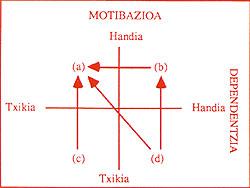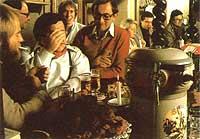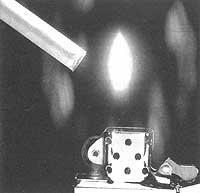Is there a magical method to quit smoking smoking (3)?
1988/08/01 Agirre, Jabier - Medikua eta OEEko kidea Iturria: Elhuyar aldizkaria

The prevalence of smoking in countries that have taken this process seriously (Great Britain, USA, Canada, Australia or Countries of the North) has decreased in all social groups and, incidentally, the incidence of diseases and premature deaths related to tobacco has decreased. But along with all the health and economic benefits of controlling the tobacco epidemic, and as important as these, we have the improvement of the quality of life of ex-smokers and the recognition of the right of non-smokers to breathe and live in an environment free of smoke and smell of tobacco.
Unfortunately, this is not our case yet. Tobacco use among us has increased in recent years. And as mentioned in another article, doctors (still) smoke more than the general population. The enormous power of the tobacco industry in our society does not allow us to expect positive changes in current consumer trends, at least in the short term. Therefore, general awareness campaigns should be accompanied by a personal or individual tour.
Quit smoking as a process
Quitting smoking should be understood within the three general principles, according to Raw:
- There is a close relationship between a person's tendency to smoking and their behavior against tobacco.
- Quitting smoking is not a punctual action, but a process that is maintained throughout many stages.
- Smoking, on a personal level, is drug addiction.
In this process of abandonment several steps are distinguished. At first the smoker is young, healthy and without worries or symptoms. Gradually the trends begin to change. The same would not be to leave the idea wrong... or still another step: it should leave it... If we still do it later, decisions come (I will try to leave it... or leave it ...) and finally, concrete sessions, after which successes or failures will emerge.
And why is it left or decided to take that step? In the study conducted among people who have been smokers, the main reasons for their importance are:
- Fear of illness: breath, bronchitis, cancer
- Improvement of the quality of life
- For savings once stopped smoking
- Aesthetic reasons (better breath, better smell and better taste)
- Seeking recognition (to brighten others, to be a good example)
- For fear of social rejection
But one thing is to decide the abandonment of tobacco, which has been a great qualitative step, and get that very different thing and keep that achievement in the long run. According to data from the US and Britain, 75% of smokers thought they should quit smoking (and even had some attempt), but they did not. In the words of the majority, they would stop knowing it.
Two are the important factors in this process: motivation and dependence. For many years, the ability of tobacco to create dependence has not been accepted and the word dependence was replaced by another (habit, vice). The World Health Organization did not recognize tobacco as a drug until 1974. Today, however, the ability of tobacco to create a psychological and pharmacological dependence is fully accepted, and hence the acceptance of smoking as a drug addiction arises.
Having seen all the above, smokers can be divided into four large groups:
a) High motivation, low dependence
This is the best situation to quit smoking. Advice can be given: To achieve this you are in the best situation.
b) High motivation, great dependence
You can reduce dependence with phrases like: Those who smoked more than you have also managed to leave it.
c) Low motivation, low dependence
Without touching dependence, we should try to increase the motivation of the smoker, affecting positive aspects of abstinence, such as risks associated with tobacco.
d) Low motivation, great dependence
This is the worst prognosis. Advice will be given, but especially the important thing is to respond to the patient's indications. I find myself well, the tobacco does not hurt me or when I smoked I found myself better and worked more.
As we have seen, the starting points can be very different, so we must adapt our resources to each case.

Many methods have been mentioned and the list would be as long as boring. But all these methods are accompanied by a role the doctor must play: give the right support and support to your patient to stop smoking. They can be simple advice or information, and at the other end are specialized techniques, along with long-term follow-up.
There are smokers who after the advice and with a small help get enough motivation to leave the tobacco. They are people who smoke 20 or more cigarettes and have about 10 years of life. They have symptoms that blame tobacco. They are convinced of the need to quit tobacco, but they do not receive any specific support for it.
Based on this reality, the special smoking treatment aims to help these smokers achieve what they have not achieved by themselves. To unlearn that habit so rooted in the life of the person who breaks the psychological dependence of the cigarette, defeats the pharmacological addiction that has generated nicotine and becomes automatic with repetition.
After a study that has lasted (and continues to progress) 30 years, today the best method to quit smoking is that of psychological and behavioral aids (tips, changes of life, etc.) Pharmacological drugs are those that combine, for example, nicotine gum.
Medical assistance is summarized in the following points:
- To indicate to the patient the risks derived from smoking.
- Emphasize the advantages of quitting smoking.
- Remember that there is no magic solution.
- Put in place a plan.
- Motivate the patient (I think you have to quit tobacco).
- Specify a specific day of abandonment. To do this, we must negotiate with the patient (When do we want to start? ).
- Develop a list of places and conditions related to cigarettes and plan for their possible withdrawal.
- Find someone else who wants to leave tobacco nearby (it is easier).
- Recommend exercise (this reduces the urge to smoke).
- etc.

Gai honi buruzko eduki gehiago
Elhuyarrek garatutako teknologia





